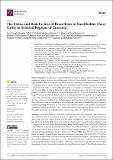| dc.description.abstract | Bovine brucellosis is a bacterial zoonoses caused by Brucella abortus. We conducted a cross-sectional study to determine brucellosis seroprevalence and risk factors among smallholder dairy cattle across six regions in Tanzania. We sampled 2048 dairy cattle on 1374 farms between July 2019 and October 2020. Sera were tested for the presence of anti-Brucella antibodies using a competitive enzyme-linked immunosorbent assay. Seroprevalence was calculated at different administrative scales, and spatial tests were used to detect disease hotspots. A generalized mixed-effects regression model was built to explore the relationships among Brucella serostatus, animals, and farm management factors. Seroprevalence was 2.39% (49/2048 cattle, 95% CI 1.7–3.1) across the study area and the Njombe Region represented the highest percentage with 15.5% (95% CI 11.0–22.0). Moreover, hotspots were detected in the Njombe and Kilimanjaro Regions. Mixed-effects models showed that having goats (OR 3.02, 95% C 1.22–7.46) and abortion history (OR 4.91, 95% CI 1.43–16.9) were significant risk factors for brucellosis. Education of dairy farmers regarding the clinical signs, transmission routes, and control measures for brucellosis is advised. A One Health approach is required to study the role of small ruminants in cattle brucellosis and the status of brucellosis in dairy farmers in the Njombe and Kilimanjaro Regions. | en_US |

